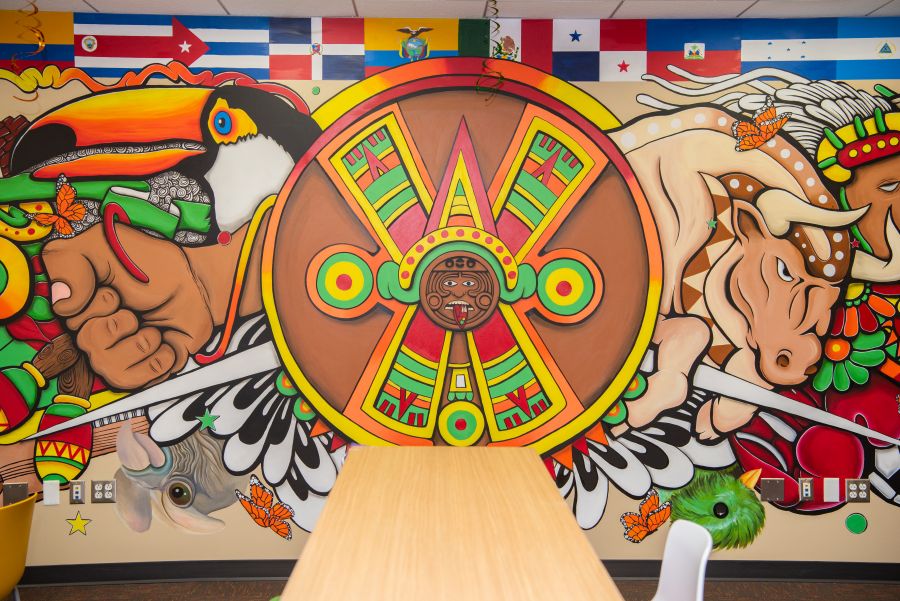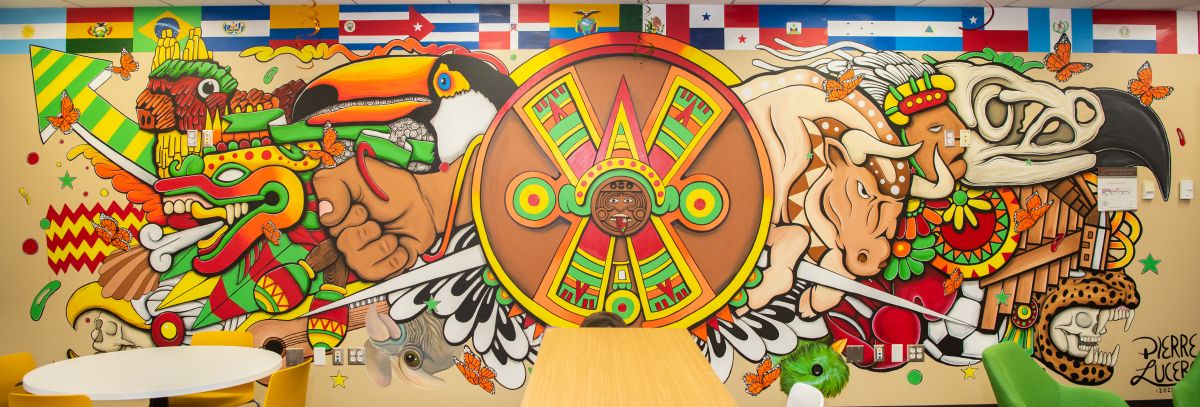


Visitors to Waubonsee Community College's Latinx Resource Center (LRC) located at the Aurora Downtown Campus will notice a bright mural with a colorful display of imagery rooted in diverse Latinx heritage, culture, strength, and pride.
The large-scale mural painted by Aurora artist Pierre Lucero was inspired by historic and cultural images from across 21 Latin American countries. The dynamic art piece incorporates animals, popular instruments, symbols, values, and various interpretations. It took Lucero two months to complete the mural in time for the community unveiling at the LRC's grand opening earlier this year.
In the mural's center, Lucero brings together the famous Aztec Sun Stone known as the "Nahui Ollin." It derives from the Aztec calendar and collides with the "Tonatiuh," the present sun in the Aztec view of the sun. It contains four corners representing self-reflection "Tezcatlipoca (TEZ-KET-LI-POCA)," knowledge, "Tezcatlipoca (TEZ-KET-LI-POCA)," positive progression, "Huitzilopochtli (WEET-ZI-LOH-POHW-TUH-LEE)," and transformation "Xipe Totec (HE-PE-TO-TEC)."
"I love that students can come to the LRC and find familiarity as they look at the mural. Seeing them identify with the images on the mural is an inviting way to discover where students are in their academic and professional journeys," said Franklin Ortega-Palaguachi, Latinx Resource Center Manager.
"The mural also reminds me of lyrics in the popular song, "Plástico," released by famous singers Willie Colón & Rubén Blades in 1978. The song talks about how there is salvation when people study, work, and continue to be united. A verse in the song says, 'forward, forward, forward, and so we'll continue and hope for a tomorrow of hope and liberty,’ and that's what we aspire to do here at the LRC,'" said Ortega-Palaguachi.
Above the mural, a procession of colorful flags is proudly displayed, each representing one of the 21 Latin American countries in a roll call of unity.
"I want people to be rooted, to have a sense of familiarity. When you look at the mural, you realize you don't have to lose your roots," said Lucero.
As a Hispanic Serving Institution, Waubonsee offers a space for Waubonsee students, faculty, alumni, and the community to connect, find belonging, and be inspired. It also adds to the vibrancy of the City of Aurora as it gives the community an inviting spot to gather while seeking to learn more about the LRC.
Waubonsee student Emily Ruiz participated in the LRC's grand opening in March by giving tours, and she has been involved ever since then. "Being part of the LRC has shown me never to give up on my dreams and embrace my culture. The leaders in the program have made me feel that I can be a successful Latina like many others and reach for the stars," said Ruiz.
Waubonsee's LRC provides resources, support services, and educational experiences to support students' academic and social success. The identity-based center provides a venue for students and community members to learn about Latinx culture, heritage, and traditions.

Below is a legend containing the meaning behind prominent images represented in the mural at the LRC:
"El Condor" The Condor: The Condor is the national bird of Ecuador, Bolivia, Chile, and Colombia. Each country interprets the meaning of the Condor on its national shield differently. In Ecuador, the Condor symbolizes grandness, value, and power. In Bolivia, the Condor represents boundaryless pursuit. In Chile, the Condor represents strength, while Columbia represents liberty and order.
Toucan: The Toucan bird is native to the Neotropics from South to Northern Argentina, Southern Mexico, and Central America. It symbolizes self-confidence because of its noisy sounds. South American tribes consider them to be sacred birds. Toucans have the longest bill of any bird in the world in relation to their body size. Their beaks are made of keratin (like human hair). The Toucan is also the national bird of Belize.
Guitar/Maracas: Guitars and maracas are popular instruments used in Latin American music.
"Quetzalcoatl”: The "Feathered Serpent," a creator god, credited to the contribution of mankind itself. A mix of a rattlesnake & a quetzal (bird), the Quetzalcoatl also symbolizes life & death.
Fist: The raised fist represents strength, power, and resilience.
Piñata: The piñata represents unity and celebration.
Monarch Butterflies: The Monarch butterflies represent the plight of undocumented immigrants and students. They also symbolize freedom, change, rebirth, and transformation.
"Alebrije": The fantasy bull creature represents strength, power, hard work, and stamina. Lucero intentionally placed the bull with the fists lifted on the opposite ends to represent balanced power. Alebrijes originated from artist Pedro Linares after he became sick and had a dream that consisted of colorful animals that chanted, "Alebrijes, Alebrijes, Alebrijes" to him. In most Latin American countries, they are viewed as spirit animals that help guide people through their lives.
Indigenous Man: The indigenous man represents the lived experience of the indigenous people who originated from Latin American countries. The indigenous man is painted without irises or pupils to represent immortality.
Jaguar Headdress & Eagle Headdress: Aztec members embraced fashion to represent status and power. High members of the Aztecs, like the ruling class, warriors, and priests, wore Jaguar headdresses and Eagle headdresses.
"El Castillo" Castle: The imagery of a castle is part of the current seven Wonders of the World and is a significant & widely recognized building in Latin American countries. It also ties in with the Mayan calendar.
"Quetzal(KET-SAL)" Bird: The Quetzal bird can be found in the lowland rainforests of Central America. It is the national bird of Guatemala and is viewed as a sacred bird by the Mayans.
Soccer/Boxing Gloves: Soccer and boxing are popular sports in Latin American countries.
Golden Eagle Skull: The golden Eagle skull is inspired by the Eagle on the Mexican flag.
Aztec Sun Stone: The Aztec Sun Stone is a widely recognized sculpture created by indigenous people from the Valley of Mexico that ruled the Aztec Empire. The Tonatiuh represents the god of the sun and is also the fifth sun and current sun from the Aztec Sun Stone.
Waubonsee student Gisselle Valdez enjoys the support she has received from the LRC. "The LRC has opened opportunities for my personality to put myself out there," said Valdez. "It feels good to know there is a community rooting for me."
In addition to the strong social and cultural connections the LRC offers to students and community members, it also provides year-long academic success programs to address common barriers students face to completing a degree. Topics include paying for college and balancing family and school. The center is open from 8 a.m. to 4:30 p.m. Monday through Friday. Visit waubonsee.edu/lrc to learn more.

